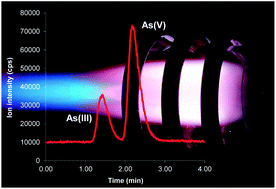The effect of common arsenic species on the ICP-MS signal working at a low liquid flow rate was investigated, taking into account the influence of the analytical concentration and of the matrix, comparing various sample introduction systems. Significant decrease (up to 65%) in the relative sensitivity of arsenite compared to arsenate was found, while methylarsonate, dimethylarsinate and arsenobetaine gave the same response (within 6%) as arsenate, throughout the 20–1000 μL min−1 liquid flow rate range. The effect was independent of the analytical concentration in the 1–100 μg L−1 range, and it was ascribed to processes related to both the sample introduction system and the ion generation and transport. Ion defocussing due to dissimilar kinetic energy of the arsenic ions generated from arsenite and arsenate was ruled out. Results obtained by various micronebulizer/spray chamber configurations showed that the temperature of the spray chamber is relevant in determining the relative responses of the arsenic species: heating the spray chamber at 60 °C caused a decrease in relative sensitivity of arsenite and dimethylarsinate compared to arsenate, while the arsenite-to-arsenate signal ratio was improved by cooling at 4 °C. The relative response of arsenite and arsenate was also significantly influenced by the presence of ammonium phosphate, which mitigated the difference between the species using conventional sample introduction devices. The influence of the chemical species on the ICP-MS signal was also investigated for species of other elements, finding significant differences in sensitivity for Hg, Se and Sn compounds when working at a low liquid flow rate. The results proved to have an effect on the accurate quantification of total concentration, as well as for arsenic speciation analysis by μHPLC/ICP-MS.

You have access to this article
 Please wait while we load your content...
Something went wrong. Try again?
Please wait while we load your content...
Something went wrong. Try again?


 Please wait while we load your content...
Please wait while we load your content...